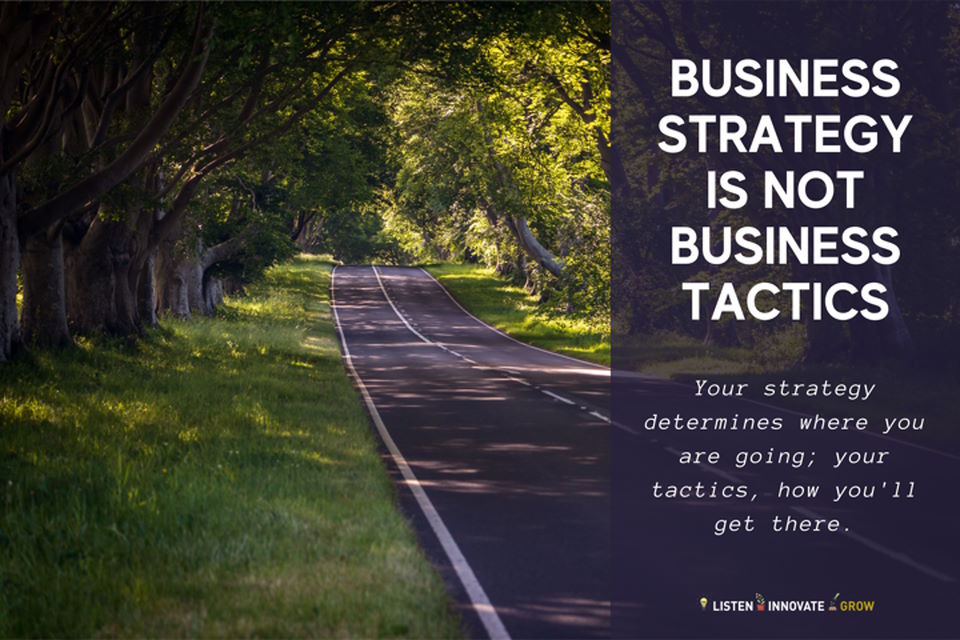Does your accounting, law, or technology firm have a B2B-focused growth strategy? With the many changes in buyer behaviours and expectations occurring across B2B markets, now more than ever is the time to make sure you have a defined strategic plan and roadmap for your business to follow.
Developing and implementing an effective business strategy will help you acquire, retain and nurture your client base is critical to your SME’s business growth.
In this article, we’ll cover what you need to know about the why and how of developing a business strategy. So if you want to get and stay ahead of your competition, keep reading!
What is a business strategy?
A business strategy is a framework that provides the “running sheet” of your company’s strategic direction. It’s the “how to” of positioning your business in the market, what you want to accomplish, and how you will get there. A successful strategy requires both long-term vision and short-term action plans.
Key takeaway: A business strategy defines your company’s goals, objectives, priorities and actions. And a successful strategy is about where to focus and how to win.
In “Playing to Win” by Roger Martin and Al Lafley, they state a successful strategy is ultimately about making explicit choices and then building a business around those choices.
Business strategy is not business tactics
It’s an easy trap to fall into, but business strategies are not the same as business tactics, and it’s important to understand they are two distinct concepts.
Business tactics are the actions taken by individuals within a business, while a business strategy refers to the overall direction set by leadership teams across an organization.

Your business strategy determines where you are heading; your business tactics are the roadmap of how you’ll get there.
Why is a business strategy important?
SMEs, especially when competing in larger markets, may be more susceptible to issues around financing, staffing and distribution access when up against well-resourced bigger players.
This is where a good business strategy can be worth its weight in gold! While it may take time and effort to create, it can help your SME combat these potential pitfalls and allow it to:
- Identify sustainable and profitable opportunities (and avoid unsuitable ones).
- Stay focused on “where you can win” (and avoid overstretching or spreading resources too thin).
- Ensure your short-term and long-term goals are relevant to your target market.
- Get all stakeholders on the same page, aligning your organization with a common purpose
- Avoid duplicating efforts and conflicting agendas

Why your company needs a business strategy for B2B
If your company is providing products, services and/or solutions to other businesses, a B2B-specific strategy is essential to achieving meaningful and measurable results. B2B markets have specific characteristics, particularly in terms of the needs, and expectations of business customers (aka “the B2B buyer”).
Without a solid B2B specific business plan in place, companies often find themselves wasting valuable time, effort, and resources on ineffective tactics that ultimately lead to frustration and a loss of revenue.
Planning a better business strategy
Your strategic planning process begins with critical self-assessment and defining your business goals. Within these goals, you will need to identify your business objectives, your plans, and the actions you’ll take towards achieving them.
Using the simple 6-step methodology we’ll describe below, the strategic plan you create will provide you with a roadmap aligning with your company’s core values, that shows you where to focus and how to win. It will show you what you need to deliver, how to deliver it and how to get leadership buy-in.
Where to focus
Begin by using S.M.A.R.T goals (specific, measurable, attainable, relevant, timely) to define areas of opportunity your B2B may be able to successfully build market share – e.g. a specific industry or geography, a particular market trend, or customer demographic.
For example – a professional services company such as an IT or an accounting firm, their year-end goal may be to acquire 5 new local market training companies that service 2nd tier regional (or state-based) banks
The simplest way to gather the information you need for this step is to listen: Listen to your internal teams, listen to the marketplace, and listen to the feedback of your target customers:
Listening to “You”
- Query how your leadership team and executive board view the company’s current direction and what their vision for its future is.
- Collate feedback from various departments – finance, sales & marketing, operations, customer service
- Review your company’s core values – its vision and mission statement, its business goals.
- Analyse key performance indicators – sales and profitability for the industries and markets your company currently operates in;
- Assess your company’s key assets, skills and capabilities.
Through listening to the feedback of your own company you may unearth ideas, opportunities and problems to be solved that were not previously known or considered. Any one of which may provide guidance towards your overall business objectives.
Listening to “The Market”
- Review your existing markets – products, competitors, trends, and market share.
- Analyse prospective markets that may be open to you – its products and/ or services, the competitive environment, potential customers, growth and profitability.
By completing this analysis, you will gain insights into the profitable industries and geographic markets worth pursuing. You’ll identify the trends and developments your SME should respond to and how you can differentiate and position yourselves against key competitors.

Listening to your customers
Simply put, if you’re not already listening to your customer base, you’re flying blind. Analysing the feedback and insights obtained here is critical to understanding how to grow your business. But don’t cherry-pick who you listen to. Make sure to include:
- Those that love you
- Those that hate you
- Those that never bought from you
- Previous customers
By analysing these insights and the feedback obtained, you will gain an in-depth understanding of the priorities, requirements, motivations, and preferences, your buyers and their stakeholders undertake in their purchase decision process.
Key takeaway: Remember that in B2B, you must work towards a buyer-level understanding; and critically, your buyer may not be the end user! Here are some suggestions on how to listen to your customers, and get the feedback you’re looking for.
Analysing your results
Once you have collated and analysed the results from these facets of your organization, you’ll want to assemble strategic planning workshops. These workshops should include teams from across the parts of your business that may be involved in the strategy’s execution. Through these sessions, as a team:
- Review and discuss the results and the learnings you can implement from them
- Determine which industries, markets and target audience will provide the best opportunities for success.
Now that you have a solid foundation of where your business strategy is headed, it’s time to turn up the gas and begin analysing the actions and tactics needed to execute it.

How to win.
Start with a SWOT analysis (strengths, weaknesses, opportunities and threats) to continue building your roadmap, and planning how to leverage your company’s capabilities to build the opportunities you’ve so far identified, into a competitive advantage.
Determine the business innovations you’ll need to implement.
This is one of the key steps towards a competitive strategy: The improvements required to meet the strategic goals you have set. How will you address the needs of the industries, markets and clients you will be targeting?
These innovations can be classified under:
- Product innovation
- Service innovation
- Organizational innovation
- Marketing innovation
- Process innovation
Determine the type of business strategy you’ll use.
One of the most well-known strategic planning tools is the Ansoff Matrix. It outlines four distinct business strategies – market penetration, product development, market development, and diversification – and their potential risk profiles. Seen another way, these strategies are:
- Growing your overall market
- Increasing market share
- Increasing your prices
- Extending your product offerings
For each of these pathways, the key to your SMEs success is to implement the one that most closely meets your target market’s needs, while also remaining within your own capabilities, and/or ability to expand them.
For a more in-depth look at these strategies, understanding them, and how to implement them, read 4 Growth Pathways.
Identify the capabilities required to execute your B2B strategy.
As you have built your strategy so far in this process, you’ll notice how each step builds upon what you’ve learned previously. The next step in the process then, now that you know where and how to direct your efforts, is to determine what resources and capabilities your company needs to deploy that strategy.
And with the insights already gained in this process, you’ll quickly be able to spot whether you’ll need, or already have, the:
- specific knowledge and/or expertise
- systems
- processes
- equipment
to execute your strategy successfully. This will also allow your company to identify what external factors and resources it may need, while also leveraging its existing capabilities and strengths.
Depending on the market(s) you are targeting and the tactics you will be using to do so, it is quite conceivable that gaps in business capabilities will be picked up.

One example of this was seen by the market research and insights company, The Evolved Group. They recognised that delivering customer feedback to store managers quickly was a key requirement for their large supermarket chain client.
By focusing on this need and creating a real-time online reporting dashboard, they were able to address the client’s challenge and improve the overall customer experience.
But they also saw this solution could have broader applications and went on to develop a range of online dashboard reporting technologies and capabilities that many other clients across multiple industries have now adopted with mutual benefit.
How to add business capability
If your analysis does identify gaps in your company’s capabilities and the resources available to it, you’ll need to look at the best way to add those factors to fill the gaps, ensuring you’re doing so in line with the strategy you’re going to deploy in your chosen markets.
Also ensure that in determining how to meet these capability requirements, you refer back to your earlier analyses, and keep lines of communication open with the relevant departments that may need to be involved – e.g. IT, HR, Operations and Finance
With those considerations made, there are 3 main areas you can look at to meet your capability requirements: Build, borrow and buy.
Build
- Create new processes or systems internally (process innovation)
- Co-creation with clients (process innovation)
- Joint venture/strategic alliance with another organization (organizational innovation)
- Training program implementation (organizational innovation)
Borrow
- Business loans, equipment leasing, bringing on temporary employees
Buy
- Hire permanent employees
- Purchase new systems/equipment
- Engage outsourced resources (organizational innovation)
- Acquire or merge with another business that has complementary competencies
Agreement and alignment
Congratulations! You’ve now identified all the major components of your new business strategy, including your business objectives, goals and plan of action!
You’ve listened and gathered feedback from multiple stakeholders across your company, you’ve identified potential areas of strengths and weaknesses to address, and you’ve identified what markets you can best leverage those factors into and how to do it.
By engaging relevant departments and keeping those lines of communication open throughout this process, it’s likely that you’ll already have overcome what often undoes the best-laid plans – agreement and alignment with your leadership team and/or executive board and final decision makers.
However, by following the process described above, you’ll have covered and factored in many of the objections often seen at those levels to your business development strategy.

What to watch out for when developing your business strategy.
Continual “listening” and scenario planning are critical!
Even though you may be creating your new strategic business plan as a path to moving your B2B forward, you must remain mindful that it will also be a “living document”. The markets you wish to operate successfully in are not static, and neither will your competitors be!
Ensure you keep your strategy on the right track and revisit your “Where to focus” learnings, updating them, and gathering additional feedback from the stakeholders involved.
And when major changes or developments are identified, conduct a scenario analysis to better understand their impacts, and the capabilities you’ll need to adjust your strategy accordingly.
Conduct a regular “review and reset” analysis.
So your company is adaptive to changing and uncertain conditions, when developing your strategy, be sure to factor in regular periodic reviews. The frequency of these will depend on the markets being targeted e.g. FMCG or technology-based industries will require greater oversight, perhaps even quarterly, while construction or infrastructure-based industries may only require annual reviews. Regardless of frequency though, it is important to understand:
- The major changes, developments, and disruptions that have occurred
- The potential impacts/scenarios that could arise
- What are the required capabilities?
- What strategy changes and action plans are needed to respond
Business strategy FAQ

What is the purpose of a business strategy?
The purpose of a business strategy is to provide a roadmap for achieving the goals and objectives of a business. It outlines the steps a business will take to compete in its market, differentiate itself from competitors, and achieve success.
How do I develop a business strategy?
To develop a business strategy, start by conducting research with your internal teams, your industry and the markets you operate (or wish to operate) in, and your competitors. Create a SWOT analysis to identify your strengths, weaknesses, opportunities, and threats.
Then, set clear and measurable goals and objectives and develop a plan of action to achieve them. Finally, implement the strategy and make any necessary adjustments as you go.
What are the common challenges SMEs face when creating a successful business strategy?
Common challenges that SMEs face when planning their business strategy include limited resources, a lack of expertise, and difficulty in competing with larger and more established companies.
It’s important for SMEs to be creative and innovative in their approach and to seek out resources and support to help them overcome these challenges.
How often should I review and update my business strategy?
It’s important to regularly review and update your business strategy to ensure it remains relevant and effective. Depending on your growth goals and market, this may be done on an annual basis, or more frequently if necessary.
To ensure your business strategy is successful and that your SME remains the business leader you aspire it to be, you must regularly assess progress towards your goals and objectives, making any necessary adjustments as you go.
These periodic “check-backs” will ensure your strategy remains in alignment with the needs and expectations of your target market – and that you are continuing to provide them value.

Michael has worked with micro-businesses to large corporates alike across Australia and Canada for more than 20 years, developing and implementing highly effective and successful business growth strategies and programs.
Say hello on Linkedin, or send a message via our contact form
